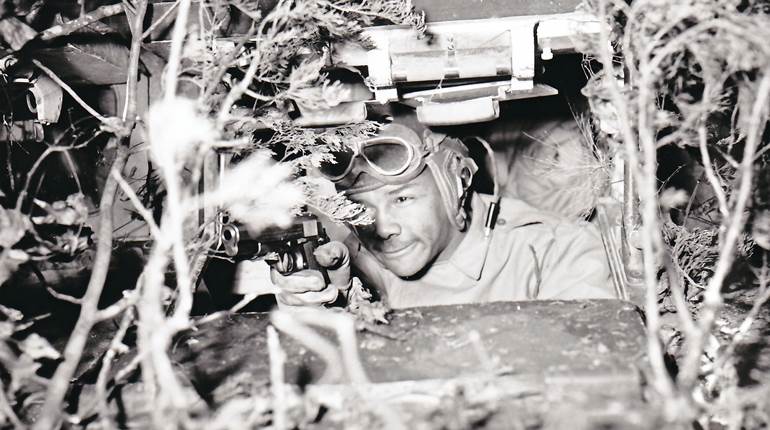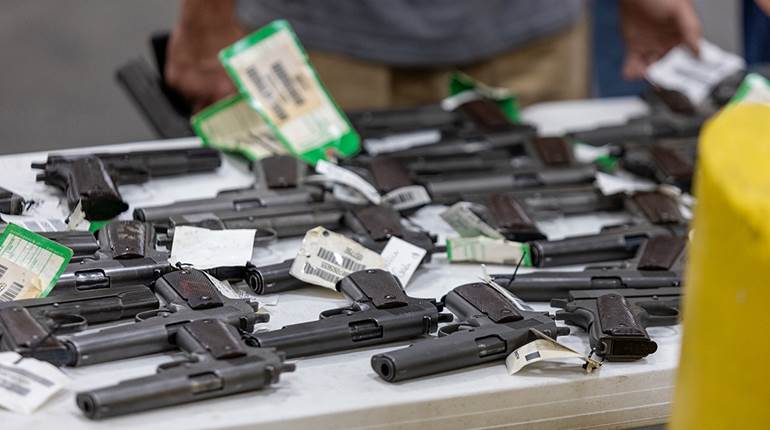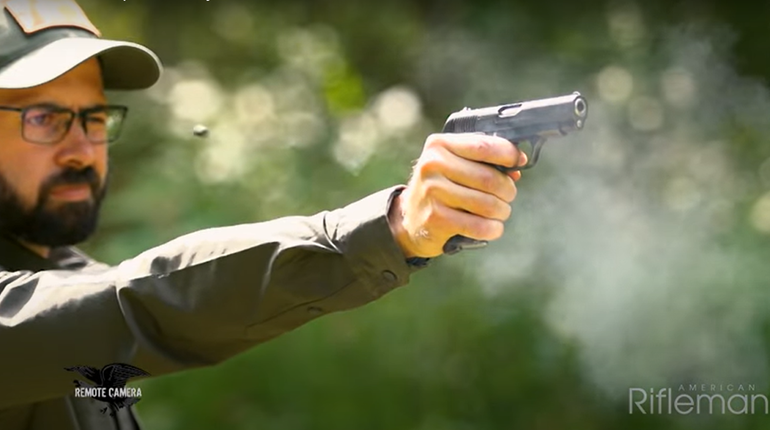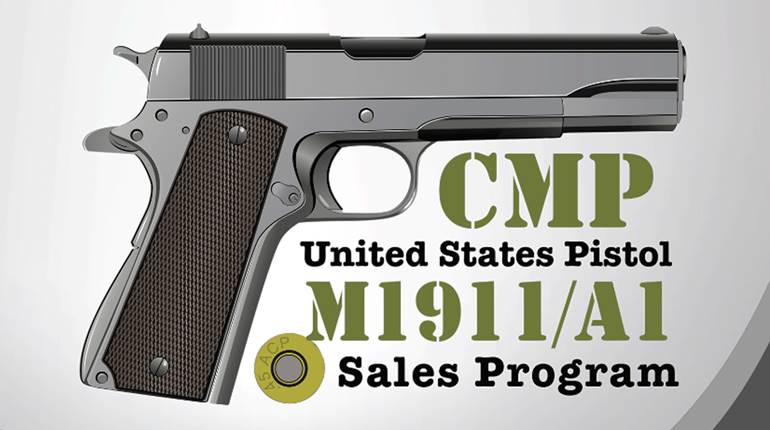
Two examples of “non-Colt” M1911s are the Springfield Armory M1911 (top) and the Remington-UMC M1911 (above) made under contract for the U.S. military. This rare variant of the Springfield Armory M1911 was made prior to World War I for sale through the Director of Civilian Marksmanship and is marked “N.R.A.” on the frame.
This article was first published in American Rifleman, June 2001
Perhaps the best-known military service pistol of all time is the “U.S. Pistol, Model of 1911, Caliber .45,” invented by the legendary John M. Browning and developed by Colt Patent Firearms Mfg. Co. The venerable “.45 automatic” has been in use by American servicemen for more than eight decades and has garnered a reputation for effectiveness and reliability rivaled by few firearms.
Colt produced large numbers of M1911 pistols from the time of the pistol’s adoption through World War I. The company also manufactured vast numbers of the later M1911A1 variant. The M1911 pistol has been inexorably linked to the Colt firm, and the term “Colt .45” is synonymous with the Model 1911 nomenclature. Nonetheless, it is sometimes overlooked that there were also a relatively limited number of M1911 .45 pistols produced by entities other than Colt. The focus of this article is on the “non-Colt” M1911 .45 pistols.
The first M1911 pistols came off Colt’s Hartford, Conn., assembly line in late 1911. The guns were crafted with the excellent workmanship for which the Colt firm had long been noted. The M1911 featured attractive rust bluing on the exterior metal surfaces and finely checkered walnut stocks. The pistol soon gained an enviable reputation as a reliable and hard-hitting service pistol.
U.S. Springfield Armory M1911s
The needs of the United States armed forces at the time were rather nominal, and Colt had little trouble meeting the demand. However, in 1914 plans were made for the M1911 pistol to be manufactured by the famed government-owned and -operated Springfield Armory in Springfield, Mass. The M1911s manufactured by Springfield Armory were essentially identical to the Colt-made variety except for the markings. Those pistols were marked “Springfield Armory/U.S.A.” on the left sides of the slides next to Colt company patent dates. The right sides of the slides were stamped with a “spread eagle” emblem. The Ordnance Department “flaming bomb” insignia was stamped on the receivers and slides. The fit and finish of the arms were equal to their Colt-made counterparts.
The serial numbers for the Springfield Armory M1911 pistols ranged between 72,571 and 133,186. The left sides of the receivers were marked “United States Property” in the same location as were the Colt-made M1911 pistols. The Springfield Armory pistols had the same type of checkered walnut stocks as found on the Colts.

An interesting and rare variant of the Springfield Armory-made pistols are the approximately 100 that were made prior to World War I for sale through the Director of Civilian Marksmanship (DCM). Those were marked “N.R.A.” and very few original examples are extant. Otherwise, the Springfield Armory M1911s were supplied to the U.S. military.
Springfield Armory manufactured 3,030 of the pistols in fiscal year 1914, 15,359 in fiscal year 1915, 4,966 in fiscal year 1916 and 2,412 in fiscal year 1917 for a total of 25,767. Production ceased in fiscal year 1917 largely because of the need for Springfield Armory to concentrate on production of the U.S. Model of 1903 rifle because of the increased demand created by America’s entry into World War I.
The M1911s produced by Springfield Armory are noteworthy because they were the last handguns made at that venerable entity and were the only handguns manufactured there during the 20th century.

Production of the M1911 by Colt and Springfield Armory was sufficient to arm the small, pre-World War I U.S. military until it became actively involved in the war. Declaration of war found the American armed forces woefully short of many arms, including M1911 pistols. There were only some 75,000 M1911s (Colt and Springfield) on hand at the time the United States declared war. Plans were formulated immediately to step up production at Colt, but it was soon evident that an even larger number of additional handguns would be needed. Both Colt and Smith & Wesson had existing production capacity to manufacture quantities of their large-frame revolvers modified to fire the .45 ACP cartridge.
Even with the U.S. M1917 revolvers becoming available, it was desired to equip our armed forces with additional quantities of M1911s. As stated, Colt immediately increased its M1911 production capacity, but the projected increase was not sufficient to meet the projected demand. Likewise, Springfield Armory was too burdened with production of the M1903 rifle to resume manufacture of the M1911 pistol. Clearly, other sources of M1911s were needed.

Remington-UMC M1911s
The Ordnance Department surveyed the potential commercial firms that were capable of manufacturing the M1911 and found a good candidate in the Remington-Union Metallic Cartridge Company. Remington-UMC had been a supplier of arms and munitions to the American military for a number of years. On December 29, 1917, the firm was awarded a contract for 150,000 M1911s.
The Remington-UMC contract specified a “target” production rate of 3,000 pistols per day to be reached as soon as feasible. However, the firm ran immediately into difficulty because the necessary production blueprints and specifications were not available. Since interchangeable parts were required, production could not begin until the requisite drawings were provided. Eventually, a complete set of production drawings and specifications were obtained by Remington-UMC, and the company began to tool up for manufacture of the M1911.
The first Remington-UMC pistols were delivered to the government in August 1918, but the company was never able to achieve the desired production rate. The company’s M1911 production contract was cancelled in December 1918, soon after the signing of the Armistice, although production did not actually cease until early 1919. By the time of the cessation of hostilities, Remington-UMC was only able to deliver some 13,152 pistols to the government. Total production was only 21,677 pistols when the final deliveries were made in early 1919.
The Remington-UMC M1911s were serially numbered consecutively from 1 through 21677. The pistols were stamped with inspectors’ initials (either “B” or “E”). The left sides of the slides were marked with Colt patent dates, the “Remington/UMC” logo arrayed in a circle and “Manufactured by/ Remington Arms UMC Co. Inc./ Bridgeport, Conn., U.S.A.” The left sides of the receivers bore the same “United States Property” markings as found on the Colt and Springfield Armory M1911s.
The Remington-UMC pistols were finished in the same rust blue as found on the pistols made by the other two entities and were fitted with the same type of checkered walnut stocks.
Although the company never achieved the production goals envisioned by the government, the Remington-UMC pistols nevertheless helped arm the Doughboys of the American Expeditionary Force. As was the case with the Colt and Springfield Armory pistols, the vast majority were subsequently overhauled (rebuilt) after World War I, and few are found today in their original “factory” condition. Surviving examples of all World War I and earlier vintage M1911 pistols in unmodified configuration are quite scarce today.
North American Arms Company M1911s
Even with increased production at Colt, and with the additional pistols being turned out by Remington-UMC, the demand for M1911 pistols continued to outpace supply. In order to address the continued demand, the Ordnance Department contacted a number of commercial firms regarding the production of M1911s: North American Arms Company (Canada); Winchester Repeating Arms Company; National Cash Register; Caron Brothers Manufacturing Company; Burroughs Adding Machine Company; Lanston Monotype Company; A.J. Savage Munitions Company and Savage Arms Corporation.
Although only two of the firms had previously manufactured firearms, it was envisioned that the combined total of pistols produced by all of the new manufacturers would be 2,550,000. However, before any of the firms could get into mass production, all contracts were cancelled after the Armistice was declared.
The only one of those companies known to have produced any complete M1911s was North American Arms Co. of Quebec, Canada, which turned out a small pre-production run of approximately 100 pistols. The North American Arms pistols were marked “Manufactured by/North American Arms Co. Limited/Quebec, Canada” on the left sides of the slides.

The North American Arms pistols were essentially identical to the Colt, Springfield Armory and Remington-UMC guns except for the markings. It is not known if any of the guns were actually issued, and surviving examples are very rare today.
 Winchester’s M1911 production program apparently did not progress beyond the blueprint stage, and some of the other proposed manufacturers did not even get that far. If the war had lasted into the Spring of 1919 as anticipated, at least some of the additional manufacturers would have been able to begin delivery of complete M1911s. As events transpired, however, that did not happen, and the only M1911s to have been manufactured during (and before) World War I were the Colt, Springfield Armory and Remington-UMC guns along with the mere handful from North American Arms.
Winchester’s M1911 production program apparently did not progress beyond the blueprint stage, and some of the other proposed manufacturers did not even get that far. If the war had lasted into the Spring of 1919 as anticipated, at least some of the additional manufacturers would have been able to begin delivery of complete M1911s. As events transpired, however, that did not happen, and the only M1911s to have been manufactured during (and before) World War I were the Colt, Springfield Armory and Remington-UMC guns along with the mere handful from North American Arms.
The names “Colt” and “M1911 .45 automatic pistol” are virtually synonymous today. While the Hartford, Conn., firm did indeed produce the overwhelming number of those handguns, the other “Non-Colt” M1911 pistols are historically significant arms.





































